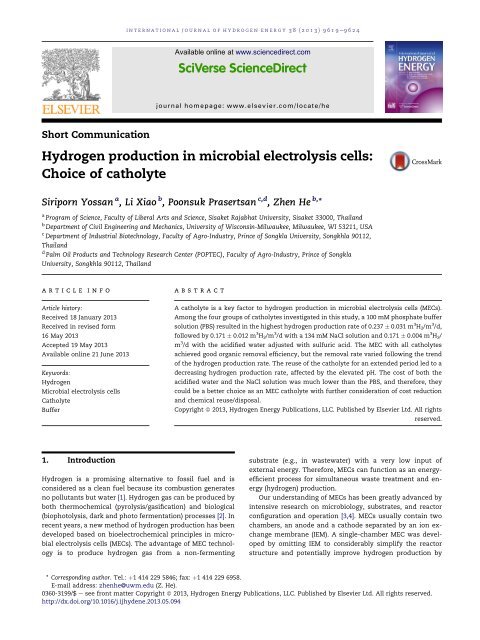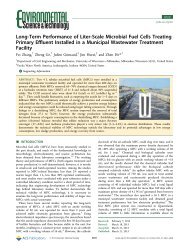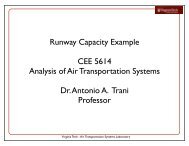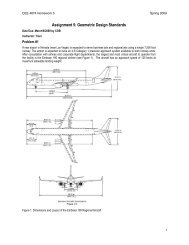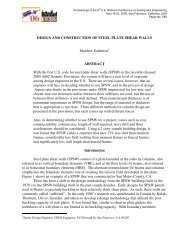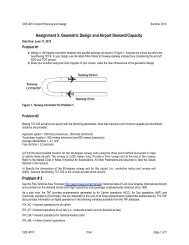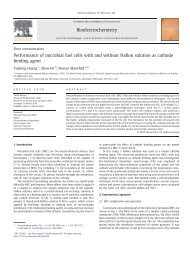Hydrogen production in microbial electrolysis cells: Choice of catholyte
Hydrogen production in microbial electrolysis cells: Choice of catholyte
Hydrogen production in microbial electrolysis cells: Choice of catholyte
Create successful ePaper yourself
Turn your PDF publications into a flip-book with our unique Google optimized e-Paper software.
<strong>in</strong>ternational journal <strong>of</strong> hydrogen energy 38 (2013) 9619e9624Available onl<strong>in</strong>e at www.sciencedirect.comjournal homepage: www.elsevier.com/locate/heShort Communication<strong>Hydrogen</strong> <strong>production</strong> <strong>in</strong> <strong>microbial</strong> <strong>electrolysis</strong> <strong>cells</strong>:<strong>Choice</strong> <strong>of</strong> <strong>catholyte</strong>Siriporn Yossan a , Li Xiao b , Poonsuk Prasertsan c,d , Zhen He b, *a Program <strong>of</strong> Science, Faculty <strong>of</strong> Liberal Arts and Science, Sisaket Rajabhat University, Sisaket 33000, Thailandb Department <strong>of</strong> Civil Eng<strong>in</strong>eer<strong>in</strong>g and Mechanics, University <strong>of</strong> Wiscons<strong>in</strong>-Milwaukee, Milwaukee, WI 53211, USAc Department <strong>of</strong> Industrial Biotechnology, Faculty <strong>of</strong> Agro-Industry, Pr<strong>in</strong>ce <strong>of</strong> Songkla University, Songkhla 90112,Thailandd Palm Oil Products and Technology Research Center (POPTEC), Faculty <strong>of</strong> Agro-Industry, Pr<strong>in</strong>ce <strong>of</strong> SongklaUniversity, Songkhla 90112, Thailandarticle <strong>in</strong>foArticle history:Received 18 January 2013Received <strong>in</strong> revised form16 May 2013Accepted 19 May 2013Available onl<strong>in</strong>e 21 June 2013Keywords:<strong>Hydrogen</strong>Microbial <strong>electrolysis</strong> <strong>cells</strong>CatholyteBufferabstractA <strong>catholyte</strong> is a key factor to hydrogen <strong>production</strong> <strong>in</strong> <strong>microbial</strong> <strong>electrolysis</strong> <strong>cells</strong> (MECs).Among the four groups <strong>of</strong> <strong>catholyte</strong>s <strong>in</strong>vestigated <strong>in</strong> this study, a 100 mM phosphate buffersolution (PBS) resulted <strong>in</strong> the highest hydrogen <strong>production</strong> rate <strong>of</strong> 0.237 0.031 m 3 H 2 /m 3 /d,followed by 0.171 0.012 m 3 H 2 /m 3 /d with a 134 mM NaCl solution and 0.171 0.004 m 3 H 2 /m 3 /d with the acidified water adjusted with sulfuric acid. The MEC with all <strong>catholyte</strong>sachieved good organic removal efficiency, but the removal rate varied follow<strong>in</strong>g the trend<strong>of</strong> the hydrogen <strong>production</strong> rate. The reuse <strong>of</strong> the <strong>catholyte</strong> for an extended period led to adecreas<strong>in</strong>g hydrogen <strong>production</strong> rate, affected by the elevated pH. The cost <strong>of</strong> both theacidified water and the NaCl solution was much lower than the PBS, and therefore, theycould be a better choice as an MEC <strong>catholyte</strong> with further consideration <strong>of</strong> cost reductionand chemical reuse/disposal.Copyright ª 2013, <strong>Hydrogen</strong> Energy Publications, LLC. Published by Elsevier Ltd. All rightsreserved.1. Introduction<strong>Hydrogen</strong> is a promis<strong>in</strong>g alternative to fossil fuel and isconsidered as a clean fuel because its combustion generatesno pollutants but water [1]. <strong>Hydrogen</strong> gas can be produced byboth thermochemical (pyrolysis/gasification) and biological(biophotolysis, dark and photo fermentation) processes [2]. Inrecent years, a new method <strong>of</strong> hydrogen <strong>production</strong> has beendeveloped based on bioelectrochemical pr<strong>in</strong>ciples <strong>in</strong> <strong>microbial</strong><strong>electrolysis</strong> <strong>cells</strong> (MECs). The advantage <strong>of</strong> MEC technologyis to produce hydrogen gas from a non-ferment<strong>in</strong>gsubstrate (e.g., <strong>in</strong> wastewater) with a very low <strong>in</strong>put <strong>of</strong>external energy. Therefore, MECs can function as an energyefficientprocess for simultaneous waste treatment and energy(hydrogen) <strong>production</strong>.Our understand<strong>in</strong>g <strong>of</strong> MECs has been greatly advanced by<strong>in</strong>tensive research on microbiology, substrates, and reactorconfiguration and operation [3,4]. MECs usually conta<strong>in</strong> twochambers, an anode and a cathode separated by an ion exchangemembrane (IEM). A s<strong>in</strong>gle-chamber MEC was developedby omitt<strong>in</strong>g IEM to considerably simplify the reactorstructure and potentially improve hydrogen <strong>production</strong> by* Correspond<strong>in</strong>g author. Tel.: þ1 414 229 5846; fax: þ1 414 229 6958.E-mail address: zhenhe@uwm.edu (Z. He).0360-3199/$ e see front matter Copyright ª 2013, <strong>Hydrogen</strong> Energy Publications, LLC. Published by Elsevier Ltd. All rights reserved.http://dx.doi.org/10.1016/j.ijhydene.2013.05.094
9620<strong>in</strong>ternational journal <strong>of</strong> hydrogen energy 38 (2013) 9619e9624reduc<strong>in</strong>g the MEC’s <strong>in</strong>ternal resistance [5]. However, a greatconcern with the s<strong>in</strong>gle-chamber MECs is methane <strong>production</strong>,which is caused by methanogens <strong>in</strong>habit<strong>in</strong>g the adjacentcathode and has been observed <strong>in</strong> several MECs <strong>in</strong>clud<strong>in</strong>g apilot test [6]. Therefore, to produce high-purity hydrogen gas<strong>in</strong> an MEC, IEM may still be a preferable separator to prevent<strong>microbial</strong> contam<strong>in</strong>ation <strong>in</strong> the cathode. With an IEM and aseparated cathode chamber, a simple but important questionarises: what should be the <strong>catholyte</strong>?A commonly used <strong>catholyte</strong> is a phosphate buffered solution(PBS), which can m<strong>in</strong>imize the pH elevation and provide acerta<strong>in</strong> electrolyte conductivity; however, the use <strong>of</strong> PBS maynot be economical and environmentally friendly. The anodeeffluent (treated wastewater) could be a low-cost <strong>catholyte</strong>,which has been studied <strong>in</strong> <strong>microbial</strong> fuel <strong>cells</strong> (MFCs) [7], but itcan <strong>in</strong>troduce microorganisms <strong>in</strong>clud<strong>in</strong>g methanogens <strong>in</strong>tothe cathode chamber, result<strong>in</strong>g <strong>in</strong> methane <strong>production</strong>. Thus,we should avoid any <strong>catholyte</strong>s conta<strong>in</strong><strong>in</strong>g <strong>microbial</strong> sources.In addition to PBS, several other <strong>catholyte</strong>s have been studied,<strong>in</strong>clud<strong>in</strong>g salt solutions and bicarbonate buffers. In general,there is very limited <strong>in</strong>formation available about the comparisonbetween these and other potential <strong>catholyte</strong>s <strong>in</strong> terms<strong>of</strong> performance and cost. In this study, we aim to exam<strong>in</strong>efour different <strong>catholyte</strong>s and provide suggestions on optimalchoices <strong>of</strong> a <strong>catholyte</strong> <strong>in</strong> an abiotic cathode for susta<strong>in</strong>ablehydrogen <strong>production</strong> <strong>in</strong> an MEC.2. Materials and methods2.1. MEC set up and operationAn MEC was made from two glass bottles, which were jo<strong>in</strong>edby a cation exchange membrane (Membranes International,Inc., GlenRock, NJ, USA). Each bottle had a liquid volume <strong>of</strong>120 mL. The anode electrode was a carbon brush (GordonBrush Mfg. Co., Inc., Commerce, CA, USA), and the cathodeelectrode was a piece <strong>of</strong> carbon cloth (Zoltek Corporation, St.Louis, MO, USA) with a length <strong>of</strong> 4 cm and a width <strong>of</strong> 3 cm. Thecathode electrode was coated with Pt as a catalyst (0.5 mg Pt/cm 2 ) [8]. Both the anolyte and the <strong>catholyte</strong> were cont<strong>in</strong>uouslymixed by magnetic stirrers. An external voltage (0.8 V) wasapplied to the circuit by connect<strong>in</strong>g the negative pole <strong>of</strong> apower supply (3644 A, Circuit Specialists, Inc., Mesa, AZ, USA)Fig. 1 e Current generation <strong>in</strong> the MEC with different <strong>catholyte</strong>s: (A) 100, 50, 25 and 10 mM PBS; (B) 134, 100 and 200 mMNaCl; (C) DI and tap water; and (D) acidified water at pH 4 and pH 2 adjusted by H 2 SO 4 or HCl.
<strong>in</strong>ternational journal <strong>of</strong> hydrogen energy 38 (2013) 9619e9624 9621Table 1 e Coulombic efficiencies and hydrogen <strong>production</strong> <strong>in</strong> the MEC with different <strong>catholyte</strong>s.Catholytes Time period (day) Coulombicrecovery: CR (%)Cathodic H 2recovery: R cat (%)Overall H 2recovery: R H2 (%)H 2 <strong>production</strong>rate: Q H2 (m 3 H 2 /m 3 /d)100 mM PBS 1.44 0.10 34.6 1.0 89.2 9.2 30.8 2.3 0.237 0.03150 mM PBS 1.06 0.06 18.7 2.0 89.2 6.6 16.7 1.4 0.165 0.00525 mM PBS 1.11 0.07 13.2 0.4 80.1 3.7 10.6 0.8 0.100 0.00710 mM PBS 1.29 0.07 8.0 0.5 69.9 8.1 5.6 0.3 0.048 0.007134 mM NaCl 2.01 0.12 26.5 1.5 120.4 4.4 31.8 1.2 0.171 0.012100 mM NaCl 1.55 0.06 19.8 1.4 91.2 3.4 18.0 0.8 0.116 0.004200 mM NaCl 1.30 0.07 19.7 3.5 93.7 5.0 18.4 2.8 0.143 0.009DI water 5.10 1.47 42.8 6.8 67.9 12.6 28.5 1.4 0.065 0.021Tap water 3.14 0.61 10.9 2.6 93.8 22.1 9.8 0.1 0.034 0.007Acidified water (pH 4) a 2.81 0.18 11.0 2.1 156.3 17.3 17.0 1.3 0.065 0.002Acidified water (pH 2) a 1.19 0.05 21.5 0.8 84.7 1.8 18.2 0.5 0.171 0.004Acidified water (pH 2) b 1.37 0.07 18.5 2.0 65.5 8.4 12.0 0.8 0.089 0.002a Adjusted by sulfuric acid.b Adjusted by hydrochloric acid.to an external resistor (10 U), then to the cathode electrode,and the positive pole to the anode electrode.The MEC was operated <strong>in</strong> a fed-batch mode at 20 C. Theanode chamber was <strong>in</strong>oculated us<strong>in</strong>g anaerobic sludge fromSouth Shore Water Reclamation Facility (Milwaukee, WI,USA). The anode feed<strong>in</strong>g solution was prepared <strong>in</strong> tap waterconsist<strong>in</strong>g <strong>of</strong> 1.0 g/L sodium acetate, 0.3 g/L NH 4 Cl, 1.0 g/LNaCl, 0.03 g/L MgSO 4 , 0.04 g/L CaCl 2 , 0.2 g/L NaHCO 3 , 5.3 g/LKH 2 PO 4 , 10.7 g/L K 2 HPO 4 and 1 mL/L trace elements [8]. Fourgroups <strong>of</strong> <strong>catholyte</strong>s were exam<strong>in</strong>ed <strong>in</strong> the MEC: PBS, NaClsolution, water, and acidified water. The PBS was tested <strong>in</strong>four concentrations, 10, 25, 50, and 100 mM. The NaCl solutionwas prepared by dissolv<strong>in</strong>g NaCl <strong>in</strong> tap water to 100, 134, and200 mM. Two waters, tap water and deionized (DI) water, werestudied. The acidified water was prepared <strong>in</strong> two pHs, 2 and 4,us<strong>in</strong>g hydrochloric acid (HCl) or sulfuric acid (H 2 SO 4 ). The<strong>catholyte</strong> was completely replaced when the voltage droppedbelow 2 mV. The new <strong>catholyte</strong> was flushed with nitrogen gasfor 15 m<strong>in</strong> to remove any oxygen before start<strong>in</strong>g MEC operation.The anolyte was replaced by 80% with a fresh anodefeed<strong>in</strong>g solution at the same time when the <strong>catholyte</strong> wasreplaced. Dur<strong>in</strong>g the extended-<strong>catholyte</strong> study, the anolytewas replaced when the voltage decreased below 2 mV, but the<strong>catholyte</strong> was not replenished.2.2. Measurement and analysisThe voltage was monitored and recorded every 5 m<strong>in</strong> by adigital multimeter (Keithley Instruments Co., Ltd., USA). Theconcentration <strong>of</strong> chemical oxygen demand (COD) wasanalyzed by a DR/890 colorimeter (HACH Co., Ltd., USA). ThepH was measured us<strong>in</strong>g a bench-top pH meter (Oakton InstrumentsCo., Ltd., USA) and the electrical conductivity wasmeasured by a bench-top conductivity meter (Mettler-ToledoCo., Ltd., USA). The <strong>production</strong> <strong>of</strong> hydrogen gas was measuredby water replacement and analyzed by us<strong>in</strong>g a gasTable 2 e COD removal <strong>in</strong> anolyte and characteristics <strong>of</strong> effluent <strong>catholyte</strong> with different <strong>catholyte</strong>s.Catholytes COD removal (%) COD removal rate Effluent pHConductivity (ms/cm)(g COD/m 3 /d)InitialEffluent100 mM PBS 94.6 0.3 0.54 0.04 9.2 0.2 13.97 0.01 12.15 0.2350 mM PBS 97.0 0.4 0.69 0.07 8.9 0.2 8.52 0.80 9.67 0.3525 mM PBS 97.5 0.4 0.66 0.06 10.8 0.2 4.06 0.04 5.40 0.3010 mM PBS 97.2 0.4 0.59 0.05 11.3 0.2 1.44 0.48 2.63 0.57134 mM NaCl 96.7 0.7 0.37 0.03 12.2 0.1 13.88 0.24 21.07 0.65100 mM NaCl 95.9 1.8 0.44 0.02 12.0 0.1 7.68 0.66 15.28 0.92200 mM NaCl 96.7 0.2 0.54 0.05 11.9 0.1 20.00 0.20 25.05 0.30DI water 94.6 2.3 0.15 0.04 12.6 0.1 0.01 0.00 1.56 0.08Tap water 86.6 0.8 0.24 0.05 11.6 0.4 0.30 0.02 2.53 0.50Acidified water (pH 4) a 97.4 0.1 0.27 0.01 11.9 0.4 0.05 0.01 2.94 0.38Acidified water (pH 2) a 98.2 0.3 0.66 0.02 9.0 0.7 7.37 0.05 3.61 0.25Acidified water (pH 2) b 96.8 0.2 0.51 0.03 11.0 0.4 5.46 0.02 3.27 0.49a Adjusted by sulfuric acid.b Adjusted by hydrochloric acid.
9622<strong>in</strong>ternational journal <strong>of</strong> hydrogen energy 38 (2013) 9619e9624chromatograph (Focus GC, Thermo Scientific, USA). The keyparameters were calculated as previously described [8]: thecoulombic recovery (CR) is def<strong>in</strong>ed as the total output coulombsover the total <strong>in</strong>put coulombs <strong>in</strong> acetate; the cathodichydrogen recovery (R cat ) is the ratio between the electronsconta<strong>in</strong>ed <strong>in</strong> the produced hydrogen gas and the electronsproduced as current; the overall hydrogen recovery ðR H2 Þ is thesubstrate used for the hydrogen <strong>production</strong>; and the hydrogen<strong>production</strong> rate ðQ H2 Þ is the hydrogen <strong>production</strong> per anodework<strong>in</strong>g volume per time.3. Results and discussionThe MEC performance with different <strong>catholyte</strong>s was describedby us<strong>in</strong>g three ma<strong>in</strong> parameters, electricity generation,hydrogen <strong>production</strong>, and COD removal.Fig. 1 shows the pr<strong>of</strong>ile <strong>of</strong> batch current generation withfour groups <strong>of</strong> <strong>catholyte</strong>s at different concentrations. In general,the PBS <strong>catholyte</strong>s with higher concentrations had ahigher peak current, followed by the acidified water (pH 2),and the NaCl solution. Both tap water and DI water resulted <strong>in</strong>very low peak currents. Decreas<strong>in</strong>g the PBS concentrationfrom 100 to 10 mM also decreased the peak current from31.1 1.5 to 8.2 0.4 A/m 3 (Fig. 1(A)), while <strong>in</strong>creas<strong>in</strong>g the NaClconcentration from 100 to 200 mM slightly improved the peakcurrent from 15.0 0.5 to 18.7 1.1 A/m 3 (Fig. 1(B)). Theexceptional performance <strong>of</strong> the 100-mM PBS is due to itsbuffer capacity and conductivity (Table 2). The high currentwith the NaCl <strong>catholyte</strong> is because <strong>of</strong> its high conductivity(Table 2), while the high current with the acidified water islikely due to the additional proton <strong>in</strong>put. The higher conductivity<strong>of</strong> the tap water over that <strong>of</strong> the DI water did not result <strong>in</strong>more current <strong>production</strong>: the current generation with the DIFig. 2 e Current generation (white dot) and hydrogen <strong>production</strong> rate (white square) <strong>in</strong> the MEC <strong>in</strong> the extended period <strong>of</strong><strong>catholyte</strong> reuse: (A) 100 mM PBS; (B) 134 mM NaCl; and (C) acidified water at pH 2 adjusted by H 2 SO 4 .
<strong>in</strong>ternational journal <strong>of</strong> hydrogen energy 38 (2013) 9619e9624 9623water (11.7 0.1 A/m 3 ) was twice that with the tap water(5.5 0.4 A/m 3 ), possibly because <strong>of</strong> the pH <strong>in</strong>fluence: the<strong>in</strong>itial pH <strong>of</strong> the DI water (4.7 0.0) was much lower than that<strong>of</strong> the tap water (7.3 0.3), <strong>in</strong>dicat<strong>in</strong>g that the proton supplymay have a more important role <strong>in</strong> current generation thanthe electrolyte conductivity. When the <strong>in</strong>itial pH was similar,for example, with the pH-2 water prepared by H 2 SO 4 or HCl, ahigher <strong>in</strong>fluent conductivity <strong>of</strong> the H 2 SO 4 <strong>catholyte</strong> led to ahigher peak current <strong>of</strong> (31.1 0.8 A/m 3 ) than that <strong>of</strong>25.7 0.3 A/m 3 with the HCl <strong>catholyte</strong>.<strong>Hydrogen</strong> <strong>production</strong> efficiencies and rates with different<strong>catholyte</strong>s are summarized <strong>in</strong> Table 1. The efficiency <strong>of</strong> thesubstrate-to-hydrogen (overall hydrogen recovery) varied between5% and 32%; <strong>in</strong>terest<strong>in</strong>gly, the DI water and the tapwater had comparable overall hydrogen recovery, as well ascoulombic recovery, with the other <strong>catholyte</strong>s. However, ittook a much longer time (3e5 days) for the MEC with the DI ortap water to complete a cycle, result<strong>in</strong>g <strong>in</strong> a much lowerhydrogen <strong>production</strong> rate. For the <strong>catholyte</strong>s <strong>of</strong> the PBS, theNaCl solution or the acidified water, the hydrogen <strong>production</strong>rates matched their current generation, and a higher currentled to a higher hydrogen <strong>production</strong> rate.The primary function <strong>of</strong> an MEC us<strong>in</strong>g wastewater as itsanode substrate is considered to be contam<strong>in</strong>ant removal;thus, COD reduction is a key parameter to evaluate the MECperformance. In general, the MEC achieved more than 94%<strong>of</strong> COD removal with all <strong>catholyte</strong>s except the tap water(Table 2), demonstrat<strong>in</strong>g a good performance <strong>in</strong> organicremoval. However, the COD removal rate was clearlyaffected by current generation and the period <strong>of</strong> a batchcycle, and the <strong>catholyte</strong>s such as the DI water and the tapwater with low hydrogen rates also yielded low CODremoval rates.We chose three <strong>catholyte</strong>s, 100-mM PBS, 134-mM NaCl, andacidified water pH 2 (H 2 SO 4 ), and conducted an extendedstudy without replac<strong>in</strong>g the <strong>catholyte</strong>. The peak currentdensities with the PBS and the acidified water clearlydecreased over time, but the NaCl ma<strong>in</strong>ta<strong>in</strong>ed a relativelystable current output. The hydrogen <strong>production</strong> rates, on theother hand, all decreased <strong>in</strong> the extended operat<strong>in</strong>g period(Fig. 2). Interest<strong>in</strong>gly, the hydrogen <strong>production</strong> rate with theacidified water showed a dramatic decrease <strong>in</strong> the second daywith a significant <strong>in</strong>crease <strong>in</strong> pH from 2.0 to 11.2, and thenslowly recovered <strong>in</strong> the follow<strong>in</strong>g six days with a further <strong>in</strong>crease<strong>of</strong> pH to 12.6 (Fig. 2(C)). The pH <strong>of</strong> the PBS <strong>in</strong>creasedfrom 7.3 to 12.3 <strong>in</strong> ten days and the NaCl <strong>catholyte</strong> had anelevated pH from 7.5 to 12.9 <strong>in</strong> six days. The f<strong>in</strong>al conductivity<strong>of</strong> the acidified water was 12.57 mS/cm, half <strong>of</strong> that <strong>of</strong> the PBSor NaCl <strong>catholyte</strong>s. All three <strong>catholyte</strong>s had a similar hydrogen<strong>production</strong> rate <strong>of</strong> 0.10 m 3 H 2 /m 3 /d at the end <strong>of</strong> their test<strong>in</strong>gperiod, <strong>in</strong>dicat<strong>in</strong>g that pH had more <strong>in</strong>fluence than <strong>catholyte</strong>conductivity on hydrogen <strong>production</strong>.The cost <strong>of</strong> a <strong>catholyte</strong> was estimated from the amount<strong>of</strong> the chemicals used and their bulk prices obta<strong>in</strong>ed fromSigmaeAldrich (St. Louis, USA). For an operation with frequentreplacement <strong>of</strong> the <strong>catholyte</strong> (as shown <strong>in</strong> Fig. 1), it would cost$3.39/m 3 H 2 with the 100-mM PBS, much higher than thehydrogen price ($0.42/m 3 estimated from $4.75/kg H 2 [9]). Theuse <strong>of</strong> the 134-mM NaCl or the acidified water (pH ¼ 2 adjustedby sulfuric acid) would cost $0.29/m 3 and $0.21/m 3 , respectively.In an extended use <strong>of</strong> the <strong>catholyte</strong> (as shown <strong>in</strong> Fig. 2), thecost <strong>of</strong> those three <strong>catholyte</strong>s (calculated from the first fourcycles) decreased because <strong>of</strong> the reuse: $1.50/m 3 with the100-mM PBS, $0.19/m 3 with the 134-mM NaCl, and $0.11/m 3with the acidified water (pH ¼ 2). The cost can be even less withadditional operat<strong>in</strong>g cycles us<strong>in</strong>g the same <strong>catholyte</strong> (Fig. 2(A)and (C)) and lower prices <strong>of</strong> raw chemicals <strong>in</strong> a larger quantity.Both the NaCl solution and the acidified water may be a betterchoice as an MEC <strong>catholyte</strong> than the PBS, because <strong>of</strong> thesignificantly lower cost. The use <strong>of</strong> PBS can also potentiallycause environmental problems by releas<strong>in</strong>g phosphorus <strong>in</strong>tonatural water bodies. Of course, challenges also exist with theuse <strong>of</strong> the NaCl or the acidified water and should be furtheraddressed; for example, the anode needs to have a sufficientalkal<strong>in</strong>ity when us<strong>in</strong>g a high-concentration NaCl <strong>catholyte</strong>[10], or the waste sulfate from the acidified water should beproperly disposed.4. Conclusions<strong>Hydrogen</strong> <strong>production</strong> <strong>in</strong> an MEC is affected by the pH buffer<strong>in</strong>gcapacity and the electrolyte conductivity <strong>of</strong> a <strong>catholyte</strong>. The100-mM PBS <strong>catholyte</strong> exhibited the best buffer<strong>in</strong>g capacityand also led to the highest hydrogen <strong>production</strong> rate, followedby the NaCl solution with a high electrolyte conductivity andthe acidified water that supplied additional protons to thecathode reaction. The tap/DI water, the low-concentration PBSand the acidified water at pH 4 had the lowest hydrogen <strong>production</strong>rates. The reuse <strong>of</strong> the cathode for an extended periodled to decreased hydrogen <strong>production</strong> rates, but could bejustified by cost sav<strong>in</strong>g. PBS may not be a good choice as an MEC<strong>catholyte</strong> because <strong>of</strong> its high cost and potential environmentaleffects. Both NaCl and acidified water could be considered asbetter choices. Future applications <strong>of</strong> those <strong>catholyte</strong>s <strong>in</strong> MECswill need to consider issues such as the <strong>catholyte</strong> cost (withfurther reductions), the <strong>catholyte</strong> reuse, and the disposal.AcknowledgmentsThis work was f<strong>in</strong>ancially supported by the Research Groupfor the Development <strong>of</strong> Microbial <strong>Hydrogen</strong> Production Processesfrom Biomass, Office <strong>of</strong> the Higher Education Commission,Thailand, and a research grant from the NationalScience Foundation (Award 1033505). We also thank Dr. MarjoriePiechowski (UW-Milwaukee) for pro<strong>of</strong>read<strong>in</strong>g themanuscript.references[1] Suwansaard M, Choorit W, Zeilstra-Ryalls JH, Prasertsan P.Isolation <strong>of</strong> anoxygenic photosynthetic bacteria fromSongkhla Lake for use <strong>in</strong> a two-staged biohydrogen<strong>production</strong> process from palm oil mill effluent. Int J<strong>Hydrogen</strong> Energy 2009;34:7523e9.[2] Manish S, Banerjee R. Comparison <strong>of</strong> biohydrogen<strong>production</strong> processes. Int J <strong>Hydrogen</strong> Energy 2008;33:279e86.
9624<strong>in</strong>ternational journal <strong>of</strong> hydrogen energy 38 (2013) 9619e9624[3] Liu H, Hu H, Chignell J, Fan Y. Microbial <strong>electrolysis</strong>: noveltechnology for hydrogen <strong>production</strong> from biomass. Bi<strong>of</strong>uels2010;1:129e42.[4] Kundu A, Sahu JN, Redzwan G, Hashim MA. An overview <strong>of</strong>cathode material and catalysts suitable for generat<strong>in</strong>ghydrogen <strong>in</strong> <strong>microbial</strong> <strong>electrolysis</strong> cell. Int J <strong>Hydrogen</strong> Energy2013;38:1745e57.[5] Call D, Logan BE. <strong>Hydrogen</strong> <strong>production</strong> <strong>in</strong> a s<strong>in</strong>gle chamber<strong>microbial</strong> <strong>electrolysis</strong> cell lack<strong>in</strong>g a membrane. Environ SciTechnol 2008;42:3401e6.[6] Cusick RD, Bryan B, Parker DS, Merrill MD, Mehanna M,Kiely PD, et al. Performance <strong>of</strong> a pilot-scale cont<strong>in</strong>uous flow<strong>microbial</strong> <strong>electrolysis</strong> cell fed w<strong>in</strong>ery wastewater. ApplMicrobiol Biotechnol 2011;89:2053e63.[7] Zhang F, Jacobson KS, Torres P, He Z. Effects <strong>of</strong> anolyterecirculation rates and <strong>catholyte</strong>s on electricity generation <strong>in</strong>a liter-scale upflow <strong>microbial</strong> fuel cell. Energy Environ Sci2010;3:1347e52.[8] Xiao L, Wen Z, Ci S, Chen J, He Z. Carbon/iron based nanorodcatalyst for hydrogen <strong>production</strong> <strong>in</strong> <strong>microbial</strong> <strong>electrolysis</strong><strong>cells</strong>. Nano Energy 2012;1:751e6.[9] Escapa A, Gómez X, Tartakovsky B, Morán A. Estimat<strong>in</strong>g<strong>microbial</strong> <strong>electrolysis</strong> cell (MEC) <strong>in</strong>vestment costs <strong>in</strong>wastewater treatment plants: case study. Int J <strong>Hydrogen</strong>Energy 2012;37:18641e53.[10] Nam J-Y, Logan BE. Optimization <strong>of</strong> <strong>catholyte</strong> concentrationand anolyte pHs <strong>in</strong> two chamber <strong>microbial</strong> <strong>electrolysis</strong> <strong>cells</strong>.Int J <strong>Hydrogen</strong> Energy 2012;37:18622e8.


